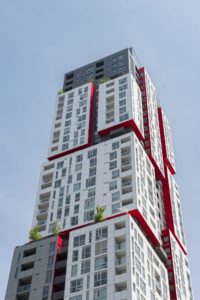This article about strata levies and the capital works fund has been supplied by Andrew Terrell, Bright & Duggan. Part 1 of this series can be read here: NSW: Where’s my money honey (Or where are my levies going)?
Formerly the sinking fund in the NSW Strata Schemes Management Act 1996, the Capital works fund (CWF) is a much better title for the fund from which capital works at a scheme must be paid from. The Capital Works fund is still called the sinking fund in the Community Lands Management Act and in other states.
GET THE LATEST STRATA NEWS / ARTICLES DIRECT TO YOUR INBOX HERE

Budgeted properly from day dot, a scheme should now have little need to raise a special levy for capital expenditure in future years.
The Act (S79) is clear on how a scheme is supposed to budget for its administrative and capital funds:
- Account properly for what funds are left in the respective fund at the end of the financial year.
- Prepare a budget for the coming year’s expenditure:
- The admin fund should be an extrapolation of the PY admin costs (with an escalation for CPI) and any other known contracted costs.
- The CWF requires an estimate for actual and expected expenditure from the fund of a capital nature, which must take into account the 10-year plan for the fund.
- Assess the levies required to meet the obligations of each fund, taking into account any prior year surplus or deficit in either fund.
Despite the Act being clear as to what is required, adequate budgeting to the CWF is still rare. I put this down to several factors:
- The 10 year plans being drafted were (and still are in some cases), not worth the paper they are printed on and the budgets inadequate when seemingly expected works arrived (painting, roof works, etc). These have improved across the board and despite being a very cheap report, are of real value when done well and implemented properly.
- Owners and strata managers fail in their obligation to budget adequately, playing catch-up with special levies when works come about.
- At brand new schemes, often the initial budget being put forward is inadequate and not based on a plan. This is easily overcome by ordering a plan once a scheme is registered, given there are not less than 2 months before the First AGM must be held.
- Buildings have fallen into such disrepair due to mismanagement by the strata manager and owners corporation that the owners are overwhelmed and refuse to implement the work they are required to do as they don’t know where to start. This leads to a loss of values and potentially a compulsory appointment of a strata manager by NCAT.
- Owners don’t know what adequate levies look like as they transpose their experience at one scheme to another, or have been led down a garden path by a developer/strata manager putting forward inadequate estimates (which despite being a breach of the 2015 Act, still happens routinely).
I am not going to go into any detail on types of expenditure that come from the capital works fund, as this relates to the building fabric (which is different at every scheme), however, these are generally the larger ticket items:
- Painting
- Roofing
- Waterproofing
- Guttering
- Hydraulics
- Fire equipment
- Landscaping
- Access control
- Carpeting/tiling
- Doors / windows
How do we fix these issues ongoing?
- Get a quality 10-year plan (which must be updated every 5 years) from the likes of Solutions In Engineering –
 ask questions about the report, particularly for any work in the near future (maybe even obtain a quote to see if the external painting work in 3 years is a realistic cost).
ask questions about the report, particularly for any work in the near future (maybe even obtain a quote to see if the external painting work in 3 years is a realistic cost). - Implement the plan – irrespective of what that means to a levy increase. If there is urgent work outstanding, perhaps draw a line in the sand and get the work done asap via a special levy or strata loan so that levies can be made lower once the work is done – e.g. a scheme has $100k in the CWF and has to do a $500k repaint in 6 months. Raise the money over years and the work becomes more expensive and more urgent due to resultant damage – get the work done asap to incur short term pain but restore value.
- Educate/educate/educate – the CWF pays for the sexy stuff that helps a building look good down the track and compete with newer stock in the market. Owners should understand that putting $1.5k-$2.5k aside each year in this fund (in the case of a new scheme) protects their asset.
As a guide, a brand new scheme (apartments/townhouses) should set aside between $1.3k-$2k per lot per annum, depending on the nature of the building and its specific maintenance requirements.
Read next:
Andrew Terrell
Bright & Duggan
E: Andrew.Terrell@bright-duggan.com.au
This post appears in Strata News #261
This article has been republished with permission from the author and first appeared on the Stratalife website.
Visit Your Strata Levies OR NSW Strata Legislation.
After a free PDF of this article? Log into your existing LookUpStrata Account to download the printable file. Not a member? Simple – join for free on our Registration page.
Have a question about a strata levies and the capital works fund in NSW or something to add to the article? Leave a comment below.

I agree with other commentators.
We good SMAs make sure the Capital Works Plans for each scheme is reviewed 5-yrly and we don’t just put it in a filing cabinet. required by the SSMAct 2015. I find it a valuable resource and show my owners the CWPlan EVERY year with their AGM papers. Not just the lengthy mathematical document but a one page summary of proposed/forecast expenditures, levies and balance in the CW Fund year by year matched against column actual outlays and balances. That way owners see what they have spent on capital works over a time frame versus what was predicted.
And when designing a budget and I feel that they have been a bit light on with their past contribution to the CWF, the comparison of current balance v predicted balance for that year can be a wake up call for owners. After all, a strata manager offers a suggested budget with the CWPlan in mind, but the owners make the ultimate decision based on their preparedness (or financial capacity) to contribute to the future.
When it comes to the 5-yrly review, the QS I use (BIV Reports Pty LTD) welcomes that historical record as it also helps with them pricing of certain works in regional centres. I have also found my Predicted v. Actual table gives purchasers more information than they could extract from a strata books inspection of primary documents. And what strata buyer doesn’t want to know how much has been spent in the past on capital works and what is potentially ahead of them.
How do you use the Capital Works Plan when it arrives?
We all have examples of mismanagement, but you serve no useful purpose in running down our industry. I’m sure given all the hard work that Chris does for the industry, that he would agree with me.
Hi Brian, I have a litany of examples of mismanagement which I won’t go into.
It’s not an attack – this is a push to educate so everyone can look to do better.
Disappointing that Andrew felt it necessary to attack his fellow strata managers in blaming them for “Buildings have fallen into such disrepair due to mismanagement by the strata manager…”, when I believe that he has no basis for making such a statement. It has been my very long experience that it is OC’s that allow their buildings to run into disrepair. Andrew should remember that we are ‘agents’ not principals and therefore can only advise and encourage owners to maintain their buildings as we are unable to force owners into undertaking repairs.
The Capital Works Fund forecasts are the same across the industry unless your OC is prepared to pay for a proper report. The generic reports do not reflect proper accounting principles particularly when they include maintenance as an expenditure item. The accounting method that should be used is the amortisation of the future cost of replacement. Repairs and maintenance would then be charged to the Administration Fund where they belong.